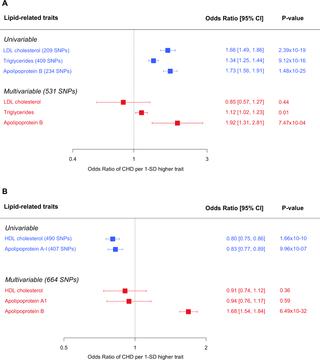PLOS Medicine ( IF 15.8 ) Pub Date : 2020-03-23 , DOI: 10.1371/journal.pmed.1003062 Tom G Richardson 1, 2 , Eleanor Sanderson 1, 2 , Tom M Palmer 1, 2 , Mika Ala-Korpela 3, 4, 5, 6 , Brian A Ference 7, 8 , George Davey Smith 1, 2 , Michael V Holmes 1, 9, 10

|
Background
Circulating lipoprotein lipids cause coronary heart disease (CHD). However, the precise way in which one or more lipoprotein lipid-related entities account for this relationship remains unclear. Using genetic instruments for lipoprotein lipid traits implemented through multivariable Mendelian randomisation (MR), we sought to compare their causal roles in the aetiology of CHD.
Methods and findings
We conducted a genome-wide association study (GWAS) of circulating non-fasted lipoprotein lipid traits in the UK Biobank (UKBB) for low-density lipoprotein (LDL) cholesterol, triglycerides, and apolipoprotein B to identify lipid-associated single nucleotide polymorphisms (SNPs). Using data from CARDIoGRAMplusC4D for CHD (consisting of 60,801 cases and 123,504 controls), we performed univariable and multivariable MR analyses. Similar GWAS and MR analyses were conducted for high-density lipoprotein (HDL) cholesterol and apolipoprotein A-I. The GWAS of lipids and apolipoproteins in the UKBB included between 393,193 and 441,016 individuals in whom the mean age was 56.9 y (range 39–73 y) and of whom 54.2% were women. The mean (standard deviation) lipid concentrations were LDL cholesterol 3.57 (0.87) mmol/L and HDL cholesterol 1.45 (0.38) mmol/L, and the median triglycerides was 1.50 (IQR = 1.11) mmol/L. The mean (standard deviation) values for apolipoproteins B and A-I were 1.03 (0.24) g/L and 1.54 (0.27) g/L, respectively. The GWAS identified multiple independent SNPs associated at P < 5 × 10−8 for LDL cholesterol (220), apolipoprotein B (n = 255), triglycerides (440), HDL cholesterol (534), and apolipoprotein A-I (440). Between 56%–93% of SNPs identified for each lipid trait had not been previously reported in large-scale GWASs. Almost half (46%) of these SNPs were associated at P < 5 × 10−8 with more than one lipid-related trait. Assessed individually using MR, LDL cholesterol (odds ratio [OR] 1.66 per 1-standard-deviation–higher trait; 95% CI: 1.49–1.86; P < 0.001), triglycerides (OR 1.34; 95% CI: 1.25–1.44; P < 0.001) and apolipoprotein B (OR 1.73; 95% CI: 1.56–1.91; P < 0.001) had effect estimates consistent with a higher risk of CHD. In multivariable MR, only apolipoprotein B (OR 1.92; 95% CI: 1.31–2.81; P < 0.001) retained a robust effect, with the estimate for LDL cholesterol (OR 0.85; 95% CI: 0.57–1.27; P = 0.44) reversing and that of triglycerides (OR 1.12; 95% CI: 1.02–1.23; P = 0.01) becoming weaker. Individual MR analyses showed a 1-standard-deviation–higher HDL cholesterol (OR 0.80; 95% CI: 0.75–0.86; P < 0.001) and apolipoprotein A-I (OR 0.83; 95% CI: 0.77–0.89; P < 0.001) to lower the risk of CHD, but these effect estimates attenuated substantially to the null on accounting for apolipoprotein B. A limitation is that, owing to the nature of lipoprotein metabolism, measures related to the composition of lipoprotein particles are highly correlated, creating a challenge in making exclusive interpretations on causation of individual components.
Conclusions
These findings suggest that apolipoprotein B is the predominant trait that accounts for the aetiological relationship of lipoprotein lipids with risk of CHD.
中文翻译:

评估循环脂蛋白脂质和载脂蛋白与冠心病风险之间的关系:多变量孟德尔随机分析。
背景
循环脂蛋白脂质会导致冠心病 (CHD)。然而,一种或多种脂蛋白脂质相关实体解释这种关系的确切方式仍不清楚。使用通过多变量孟德尔随机化 (MR) 实现的脂蛋白脂质性状遗传工具,我们试图比较它们在 CHD 病因学中的因果作用。
方法和发现
我们在英国生物银行 (UKBB) 中对循环非空腹脂蛋白脂质特征进行了全基因组关联研究 (GWAS),以检测低密度脂蛋白 (LDL) 胆固醇、甘油三酯和载脂蛋白 B,以确定脂质相关的单核苷酸多态性。单核苷酸多态性)。使用来自 CARDIoGRAMplusC4D 的 CHD 数据(包括 60,801 例病例和 123,504 例对照),我们进行了单变量和多变量 MR 分析。对高密度脂蛋白 (HDL) 胆固醇和载脂蛋白 AI 进行了类似的 GWAS 和 MR 分析。UKBB 中脂质和载脂蛋白的 GWAS 包括 393,193 至 441,016 人,其中平均年龄为 56.9 岁(范围 39-73 岁),其中 54.2% 为女性。平均(标准偏差)脂质浓度为 LDL 胆固醇 3.57 (0.87) mmol/L 和 HDL 胆固醇 1.45 (0.38) mmol/L,中位甘油三酯为 1.50 (IQR = 1.11) mmol/L。载脂蛋白 B 和 AI 的平均(标准偏差)值分别为 1.03 (0.24) g/L 和 1.54 (0.27) g/L。GWAS 确定了多个独立的 SNP对于 LDL 胆固醇 (220)、载脂蛋白 B ( n = 255)、甘油三酯 (440)、HDL 胆固醇 (534) 和载脂蛋白 AI (440),P < 5 × 10 -8 。为每种脂质性状鉴定的 SNP 中有 56%–93% 以前没有在大规模 GWAS 中报道过。这些 SNP 中几乎一半 (46%) 在P < 5 × 10 -8时与一种以上的脂质相关性状相关。使用 MR、LDL 胆固醇(优势比 [OR] 1.66 每 1 个标准差 - 更高性状;95% CI:1.49–1.86;P < 0.001)、甘油三酯(OR 1.34;95% CI:1.25–1.44;P < 0.001) 和载脂蛋白 B (OR 1.73; 95% CI: 1.56–1.91; P< 0.001) 的效应估计值与较高的 CHD 风险一致。在多变量 MR 中,只有载脂蛋白 B(OR 1.92;95% CI:1.31–2.81;P < 0.001)保留了稳健的效果,估计 LDL 胆固醇(OR 0.85;95% CI:0.57–1.27;P = 0.44)逆转和甘油三酯(OR 1.12;95% CI:1.02–1.23;P = 0.01)变弱。单个 MR 分析显示 1 个标准差 - HDL 胆固醇(OR 0.80;95% CI:0.75–0.86;P < 0.001)和载脂蛋白 AI(OR 0.83;95% CI:0.77–0.89;P< 0.001) 以降低 CHD 的风险,但这些效应估计值在考虑载脂蛋白 B 时显着减弱至零。一个限制是,由于脂蛋白代谢的性质,与脂蛋白颗粒组成相关的测量值高度相关,在对单个组件的因果关系进行独家解释方面提出了挑战。
结论
这些发现表明,载脂蛋白 B 是解释脂蛋白脂质与冠心病风险的病因关系的主要特征。



























 京公网安备 11010802027423号
京公网安备 11010802027423号